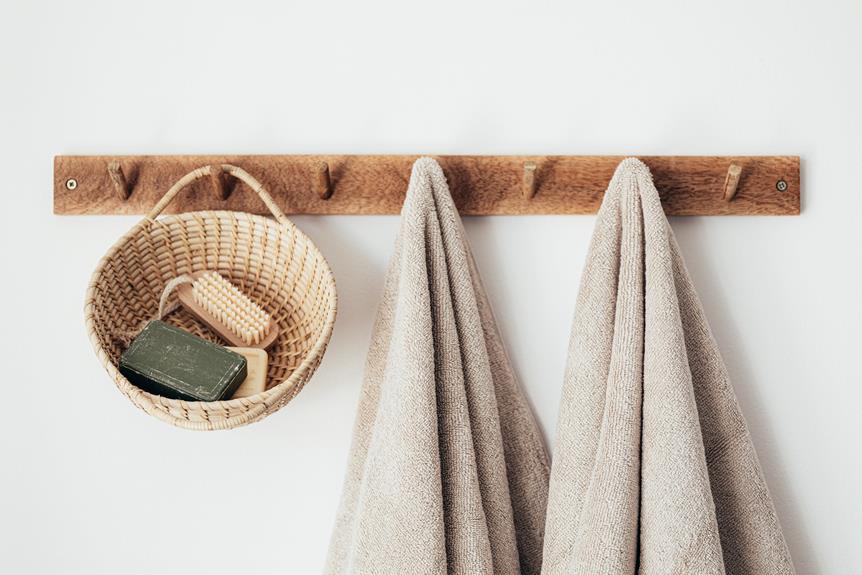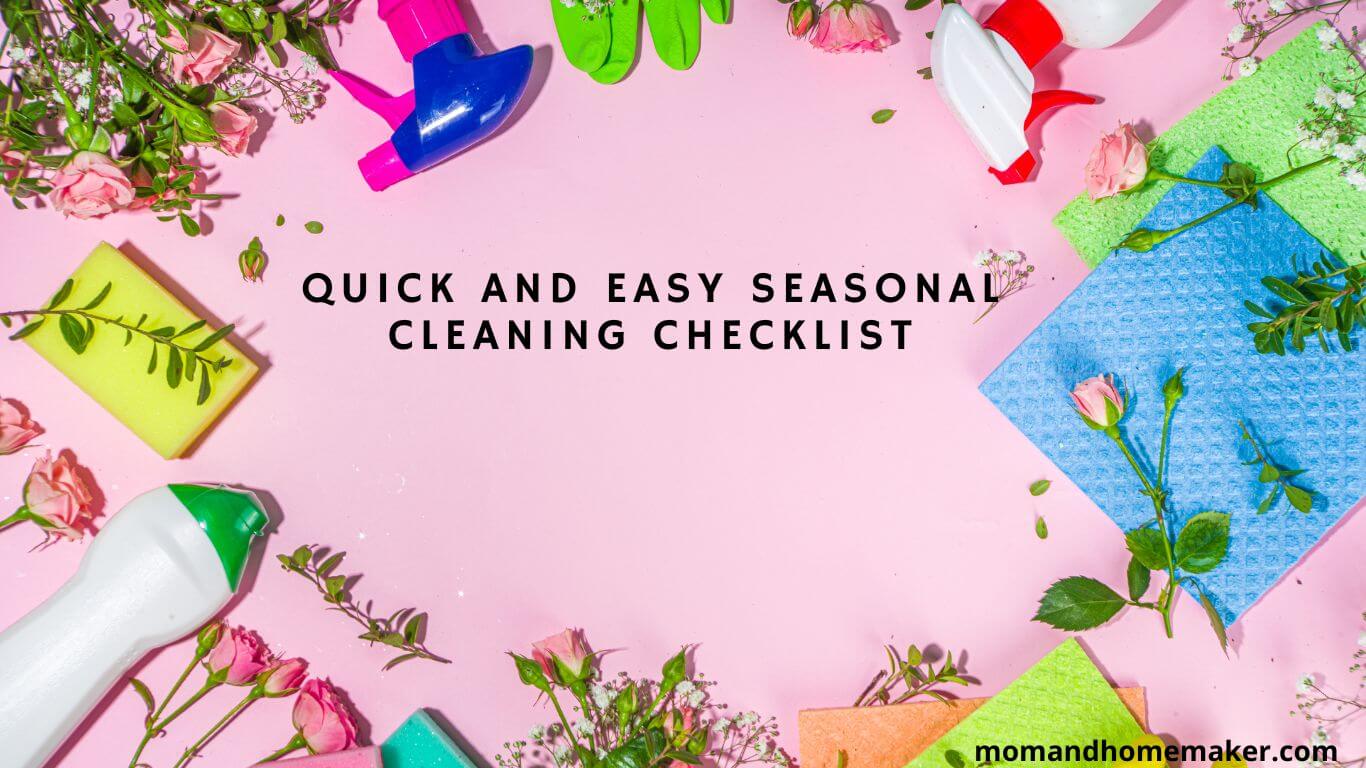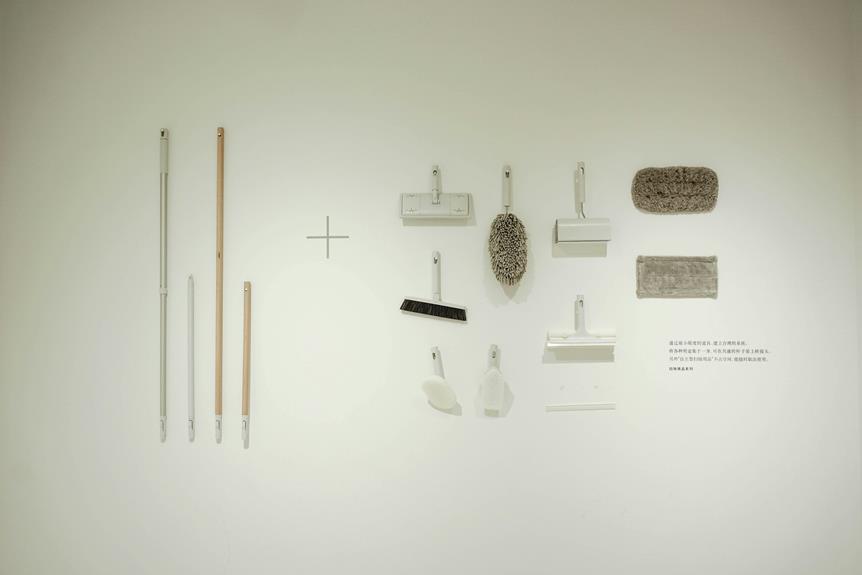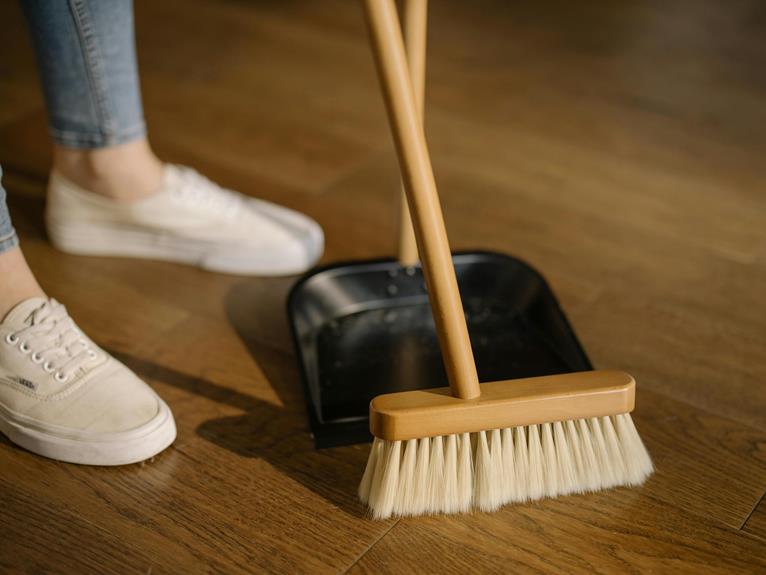When it comes to making our homes more sustainable, it’s important to consider the impact of our cleaning routines. This not only affects our health but also harms the environment.
That’s why seasonal cleaning is a great starting point for creating a cleaner and greener home.
By adopting simple and sustainable practices, we can not only improve our living space but also contribute to a more eco-friendly world.

Spring Cleaning Checklist
Here’s my spring cleaning checklist to help you efficiently tackle all your cleaning tasks.
Spring is a time of renewal and fresh beginnings, so why not embrace the season by giving your home a thorough cleaning? To make your spring cleaning experience more sustainable, I recommend using natural cleaning products and incorporating organizing tips into your routine.
Let’s start with natural cleaning products. Many store-bought cleaning products contain harmful chemicals that can be detrimental to your health and the environment. Instead, opt for natural alternatives like vinegar, baking soda, and lemon juice. Not only are these products effective at removing dirt and grime, but they’re also safe and non-toxic.
Now let’s delve into organizing tips. Spring cleaning isn’t just about cleaning, but also about decluttering and organizing your space. Start by tackling one room at a time, sorting through your belongings, and getting rid of anything you no longer need or use.
Donate or recycle items whenever possible to reduce waste. Once you’ve decluttered, create designated spaces for everything and invest in storage solutions that fit your needs. This won’t only make your home more organized but also make it easier to maintain cleanliness throughout the year.
Remember, spring cleaning is a chance to refresh your home and create a clean and organized space. By using natural cleaning products and implementing organizing tips, you can make your spring cleaning experience more sustainable and enjoyable.
Eco-Friendly Cleaning Supplies
Creating an eco-friendly cleaning routine is easy and beneficial for both the environment and your family’s health. By using natural cleaning products, you can reduce your carbon footprint and contribute to a more sustainable future. Making your own DIY cleaning recipes is a simple way to incorporate eco-friendly alternatives into your routine.
For example, you can mix equal parts vinegar and water to create an effective all-purpose cleaner that can be used on countertops, floors, and windows. If you want a fresh scent, add a few drops of essential oil like lemon or lavender.
Tough stains can be tackled with a homemade scrub made from baking soda and water. Apply the paste to the stained area and let it sit for a few minutes before scrubbing with a brush or sponge. This gentle yet effective scrub is a great alternative to harsh chemical cleaners.
If you prefer to buy cleaning supplies, look for natural products that are biodegradable, non-toxic, and made from renewable resources. Many companies now offer eco-friendly options that are free from harmful chemicals and toxins. These products can be found in stores and provide a convenient alternative to making your own cleaning solutions.
Decluttering Tips and Tricks
Creating a clutter-free home is vital for maintaining a peaceful and well-organized living space. If you want to embrace a minimalist lifestyle and establish a sustainable home environment, here are some effective organizing hacks to help you declutter:
- Start small, start now: Begin by tackling one area or room at a time. Decluttering your entire home all at once can be overwhelming. By starting small, you’ll feel accomplished and motivated to continue. Begin with a single drawer or a small closet, and gradually work your way up to larger spaces.
- Embrace the one-in, one-out rule: Adopt the habit of the one-in, one-out rule. Whenever you bring a new item into your home, whether it’s clothing, a kitchen gadget, or a decorative piece, commit to removing one item that you no longer need or use. This rule prevents clutter from accumulating over time and encourages mindful consumption.
- Designate specific spaces: Assign a dedicated place for each item in your home. This simple step makes it easier to find things when you need them and encourages you to put them back in their designated spot after use. Utilize storage bins, baskets, and dividers to keep similar items together and maintain an organized space.
Deep Cleaning for a Healthier Home
Deep cleaning is important for maintaining a healthy and hygienic home. It not only removes dirt and grime but also eliminates harmful bacteria and allergens that can affect our well-being. When deep cleaning, it’s important to use green cleaning methods and natural cleaning products, which are better for our health and the environment.
To help you get started on your deep cleaning journey, here are some common household cleaning tasks and the corresponding green cleaning methods and natural cleaning products you can use:
- Kitchen Countertops: Clean your kitchen countertops with vinegar and water solution or lemon juice.
- Bathroom Tiles: Use baking soda and water paste or tea tree oil to clean bathroom tiles.
- Carpet Stains: Treat carpet stains with club soda or white vinegar.
- Windows: Clean windows using a newspaper and vinegar solution or citrus-infused vinegar.
Sustainable Laundry Practices
Adopting sustainable laundry practices has had a significant impact on reducing my environmental footprint while keeping my clothes clean and fresh. These practices not only allow me to contribute to a healthier planet but also make me feel like I’m part of a community of individuals who care about our world. Here are three simple steps I’ve taken to make my laundry routine more sustainable:
- Upgrading to Energy-Saving Appliances: One of the best decisions I’ve made is investing in energy-efficient washing machines and dryers. These appliances use less water and electricity, which not only reduces my carbon footprint but also helps conserve natural resources. Plus, they save me money in the long run!
- Using Eco-Conscious Laundry Detergent: Making the switch to eco-friendly laundry detergents has made a noticeable difference in my laundry routine. These detergents are made from plant-based ingredients and don’t contain harmful chemicals. They not only benefit the environment but also keep my clothes clean and fresh without compromising on performance.
- Opting for Cold Water Washes: Washing clothes in cold water instead of hot or warm water not only saves energy but also helps preserve the quality of my garments. Most of the energy used during laundry goes into heating the water, so by washing in cold water, I’m reducing my energy consumption and extending the lifespan of my clothes.
Green Cleaning Solutions
When it comes to cleaning our homes, many of us may not realize the negative impact that commercial cleaning products can have on our health and the environment. Fortunately, there are natural cleaning products and homemade cleaning solutions that aren’t only effective but also safe for our families and the planet.
Natural cleaning products are a great alternative to conventional cleaners that contain harsh chemicals. These products are made from plant-based ingredients and don’t contain synthetic fragrances or dyes. Not only are they safer for our health, but they’re also biodegradable, which helps reduce pollution in our waterways.
Some popular natural cleaning products include vinegar, baking soda, and essential oils. Vinegar is a powerful all-purpose cleaner that can be used to remove stains, disinfect surfaces, and eliminate odors.
Baking soda, on the other hand, is an excellent abrasive cleaner that can tackle tough stains and odors. Essential oils not only add a pleasant scent to our homemade cleaning solutions but also have antimicrobial properties that can help kill bacteria and viruses.
In addition to natural cleaning products, homemade cleaning solutions are another sustainable option. These solutions can be easily made using ingredients that are readily available in our kitchens.
For example, a mixture of vinegar and water can be used as a window cleaner, while a paste made from baking soda and water can be used to scrub dirty and greasy surfaces.
Making the switch to green cleaning solutions isn’t only beneficial for our health and the environment, but it also allows us to take control of the products we use in our homes. With natural cleaning products and homemade solutions, we can maintain a clean and healthy living space while minimizing our impact on the planet.
Non-Toxic Pest Control Methods
To effectively address pest control without using toxic chemicals, I prefer using non-toxic methods that are safe for my family and the environment. Natural repellents and integrated pest management techniques are effective and sustainable alternatives to traditional pest control methods.
Here are three non-toxic pest control methods that I recommend:
- Essential oils: Peppermint, lavender, and eucalyptus essential oils have natural repellent properties that keep pests away. I mix a few drops of these oils with water and spray them around areas where pests are commonly found, like entry points and dark corners. These oils not only repel pests but also leave a pleasant aroma in my home.
- Biological controls: This method involves introducing natural predators or parasites to control pest populations. For example, releasing ladybugs in the garden can combat aphids, while nematodes can control soil-dwelling pests like grubs. By harnessing the power of nature, I can maintain a pest-free environment without harmful chemicals.
- Proper sanitation and maintenance: Integrated pest management emphasizes the importance of keeping our surroundings clean and well-maintained. This includes regular cleaning, proper waste disposal, and sealing entry points to prevent pests from entering our homes. By practicing good hygiene and maintenance, I create an environment that’s less attractive to pests and reduces the need for chemical interventions.
Energy-Efficient Home Maintenance
Promoting sustainability and reducing energy consumption in our homes can be achieved through energy-efficient home maintenance. One effective way to achieve this is by investing in energy-saving appliances and insulation upgrades. By doing so, we can make our homes more environmentally friendly and reduce our carbon footprint.
When it comes to energy-saving appliances, there are many options available on the market today. These include energy-efficient refrigerators, washing machines, smart thermostats, and LED light bulbs.
These appliances are designed to use less energy while still providing excellent performance. By replacing old, inefficient appliances with energy-saving ones, we can significantly reduce our energy consumption and save money on our utility bills.
Another crucial aspect of energy-efficient home maintenance is insulation upgrades. Proper insulation helps keep our homes warm in the winter and cool in the summer, reducing the need for excessive heating and air conditioning.
By improving insulation in our walls, roofs, and windows, we can prevent the loss of heat or cool air and create a more comfortable living environment. This not only saves energy but also reduces our reliance on fossil fuels for heating and cooling.
In addition to energy-saving appliances and insulation upgrades, there are other simple steps we can take to make our homes more energy-efficient. This includes sealing air leaks, installing programmable thermostats, and utilizing natural light whenever possible.
Seasonal Air Quality Improvement
Improving air quality throughout the seasons is crucial for maintaining a healthy and sustainable home. As someone who values a sense of belonging, you want to create an environment that promotes well-being for yourself and your loved ones.
Here are three ways you can enhance the air quality in your home:
- Bring nature indoors with indoor plants: Indoor plants not only add natural beauty to your living space but also help purify the air. They absorb carbon dioxide and release oxygen, while also removing toxins like benzene and formaldehyde. Consider adding spider plants, peace lilies, or snake plants as they’re excellent choices for improving air quality.
- Invest in air purifiers: Air purifiers are highly effective in removing pollutants and allergens from the air. They work by trapping particles such as dust, pollen, pet dander, and even mold spores. Look for air purifiers with HEPA filters, as they can capture particles as small as 0.3 microns, ensuring cleaner and healthier air for you and your family.
- Maintain proper ventilation: Good ventilation is crucial for improving indoor air quality. Open windows whenever possible to allow fresh air to circulate throughout your home. Use exhaust fans in bathrooms and kitchens to remove excess moisture and prevent the growth of mold and mildew. Additionally, regularly clean and replace air filters in your HVAC system to prevent the recirculation of dust and other airborne particles.
Water Conservation Techniques
To maintain a healthy and sustainable home, it’s important to focus on water conservation techniques. Conserving water not only benefits the environment but also saves money on utility bills. Two effective methods of water conservation are rainwater harvesting and greywater recycling.
Rainwater harvesting involves collecting and storing rainwater that falls on your property. This water can then be used for various purposes such as watering plants, washing cars, and flushing toilets. By utilizing this abundant resource, we can reduce our reliance on treated water from the municipal supply.
Greywater recycling, on the other hand, involves reusing water from household activities such as washing dishes, doing laundry, and taking showers. Instead of letting this water go down the drain, it can be captured, filtered, and reused for non-potable purposes like irrigation and toilet flushing. This not only conserves water but also reduces the strain on wastewater treatment plants.
Let’s compare the benefits of rainwater harvesting and greywater recycling in the table below:
| Rainwater Harvesting | Greywater Recycling |
|---|---|
| Captures rainwater for various uses | Reuses water from household activities |
| Reduces reliance on treated water | Reduces strain on wastewater treatment plants |
| Saves money on utility bills | Conserves water resources |
| Simple to implement with rain barrels or cisterns | Requires plumbing modifications and filtration systems |
Sustainable Outdoor Cleaning Practices
Maintaining a sustainable home involves incorporating sustainable outdoor cleaning practices. Taking care of our outdoor spaces not only enhances the beauty of our environment but also contributes to a healthier planet. Here are three simple and effective practices you can consider:
- Outdoor Composting: Creating a compost pile in your backyard is a great way to reduce waste and naturally nourish your garden. By composting organic materials like fruit and vegetable scraps, yard waste, and coffee grounds, you can produce nutrient-rich soil that will help your plants thrive. This method reduces the need for chemical fertilizers while preventing these materials from ending up in landfills, where they contribute to greenhouse gas emissions.
- Natural Weed Control: Instead of relying on harmful chemical weed killers, opt for natural methods to keep your outdoor spaces weed-free. One effective technique is manually pulling out weeds by hand or with a weeding tool. Another option is using natural weed control solutions like vinegar or saltwater. These alternatives are safer for the environment as they don’t contaminate soil or water sources.
- Rainwater Harvesting: Collecting rainwater is a sustainable way to water your outdoor plants and reduce water consumption. Set up rain barrels or a rainwater harvesting system to capture and store rainwater. You can then use this collected water for watering your garden, cleaning outdoor surfaces, or even washing your car. By utilizing rainwater, you’re conserving precious freshwater resources and reducing strain on public water supplies.
Conclusion
Spring cleaning isn’t just about tidying up our homes; it’s also an opportunity to make our lives more sustainable.
By using environmentally friendly cleaning supplies, clearing out clutter, and doing a thorough deep clean, we can create a healthier living environment.
It’s important to adopt sustainable laundry practices, maintain our homes in an energy-efficient way, and conserve water to reduce our carbon footprint.
Let’s not forget about improving air quality and using sustainable methods for outdoor cleaning.
With these simple steps, we can transform our homes into a sustainable sanctuary that even Mother Nature would be proud of.










